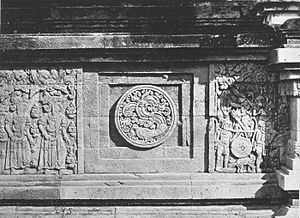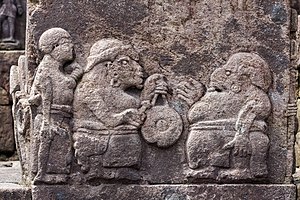
Gamelan is the traditional ensemble music of the Javanese, Sundanese, and Balinese peoples of Indonesia, made up predominantly of percussive instruments. The most common instruments used are metallophones played by mallets and a set of hand-played drums called kendang, which register the beat. The kemanak and gangsa are commonly used gamelan instruments in Bali. Other instruments include xylophones, bamboo flutes, a bowed instrument called a rebab, a zither-like instrument siter and vocalists named sindhen (female) or gerong (male).

Pelog is one of the essential tuning systems used in gamelan instruments that has a heptatonic scale. The other, older, scale commonly used is called slendro. Pelog has seven notes, but many gamelan ensembles only have keys for five of the pitches. Even in ensembles that have all seven notes, many pieces only use a subset of five notes, sometimes the additional 4th tone is also used in a piece like western accidentals.

SlendroPlay (help·info) is one of the essential tuning systems used in gamelan instruments that have pentatonic scale. Based on Javanese mythology, the Slendro Gamelan tuning system is older than the pélog tuning system.

Gamelan surakarta A typical large, double gamelan in contemporary solo (Surakarta) will include, in the sléndro set, one saron panerus, two saron barung, one or two saron demung, one gendér panerus, one gender barung, one slenthem, one bonang panerus and one bonang barung, one gambang kayu, one siter or celempung, one rebab, one suling, one pair of kethuk and kempyang, one set of three to five kenong, one set of three to five kempul, one to three gong suwukan, and one gong ageng.

The Music of Java embraces a wide variety of styles, both traditional and contemporary, reflecting the diversity of the island and its lengthy history. Apart from traditional forms that maintain connections to musical styles many centuries old, there are also many unique styles and conventions which combine elements from many other regional influences, including those of neighbouring Asian cultures and European colonial forms.

A gamelan gadhon is an ensemble consisting of the 'soft' instruments of the Javanese gamelan. This can include rebab, gendér, gendér panerus, voice, slenthem, suling, siter, gong, kempul, kenong and kendhang.

A gendèr is a type of metallophone used in Balinese and Javanese gamelan music. It consists of 10 to 14 tuned metal bars suspended over a tuned resonator of bamboo or metal, which are tapped with a mallet made of wooden disks (Bali) or a padded wooden disk (Java). Each key is a note of a different pitch, often extending a little more than two octaves. There are five notes per octave, so in the seven-note pélog scale, some pitches are left out according to the pathet. Most gamelans include three gendèr, one for sléndro, one for pelog pathet nem and lima, and one for pelog pathet barang.

Mantle Hood was an American ethnomusicologist. Among other areas, he specialized in studying gamelan music from Indonesia. Hood pioneered, in the 1950s and 1960s, a new approach to the study of music, and the creation of the first American university program devoted to ethnomusicology, at the University of California, Los Angeles (UCLA). He was known for a suggestion, somewhat novel at the time, that his students learn to play the music they were studying.

A kempul is a type of hanging gong used in Indonesian gamelan. The kempul is a set of pitched, hanging, knobbed gongs, often made of bronze, wood, and cords. Ranging from 19 cm to 25,4 cm in diameter, the kempul gong has a flat surface with a protruding knob at the center and is played by hitting the knob with the "soft end of a mallet." "The wooden mallet used has a ball shape head with heavy padding on a short wooden handle. The number of kempul gongs present in a gamelan ensemble varies but, "although there can be two to ten kempul on one separate rack, it is common to have five kempul hanging on the same rack as the Gong ageng and gong siyem".

The slenthem is an Indonesian metallophone which makes up part of a Javanese gamelan orchestra. The slenthem is part of the gendér family. It consists of a set of bronze keys comprising a single octave: there are six keys when playing the slendro scale and seven when playing the pelog. These keys are suspended by leather cords over individual bamboo tube resonators in a wooden frame, which are cut so that the placement of the bamboo's node causes the functional length of the resonator to be shorter for higher notes. The instrument is played by striking the keys with a mallet, called a tabuh, which has a short handle and a thin wooden disk edged in cloth or rubber. One hand is left free to dampen notes. It is a low-pitched instrument with a softer sound than the saron demung.

A gambang, properly called a gambang kayu is a xylophone-like instrument used among people of Indonesia in gamelan and kulintang, with wooden bars as opposed to the metallic ones of the more typical metallophones in a gamelan. A largely obsolete instrument, the gambang gangsa, is a similar instrument made with metal bars.

The saron is a musical instrument of Indonesia, which is used in the gamelan. It normally has seven bronze bars placed on top of a resonating frame (rancak). It is usually about 20 cm (8 in) high, and is played on the floor by a seated performer. In a pelog scale, the bars often read 1-2-3-5-6-7 across ; for slendro, the bars are 6-1-2-3-5-6-1; this can vary from gamelan to gamelan, or even among instruments in the same gamelan. Slendro instruments commonly have only six keys. It provides the core melody (balungan) in the gamelan orchestra.

The bonang is an Indonesian musical instrument used in the Javanese gamelan. It is a collection of small gongs placed horizontally onto strings in a wooden frame (rancak), either one or two rows wide. All of the kettles have a central boss, but around it the lower-pitched ones have a flattened head, while the higher ones have an arched one. Each is tuned to a specific pitch in the appropriate scale; thus there are different bonang for pelog and slendro. They are typically hit with padded sticks (tabuh). This is similar to the other cradled gongs in the gamelan, the kethuk, kempyang, and kenong. Bonang may be made of forged bronze, welded and cold-hammered iron, or a combination of metals. In addition to the gong-shaped form of kettles, economical bonang made of hammered iron or brass plates with raised bosses are often found in village gamelan, in Suriname-style gamelan, and in some American gamelan. In central Javanese gamelan there are three types of bonang used:

Colotomy is an Indonesian description of the rhythmic and metric patterns of gamelan music. It refers to the use of specific instruments to mark off nested time intervals, or the process of dividing rhythmic time into such nested cycles. In the gamelan, this is usually done by gongs of various size: the kempyang, ketuk, kempul, kenong, gong suwukan, and gong ageng. The fast-playing instruments, kempyang and ketuk, keep a regular beat. The larger gongs group together these hits into larger groupings, playing once per each grouping. The largest gong, the gong ageng, represents the largest time cycle and generally indicates that that section will be repeated, or the piece will move on to a new section.
Notation plays a relatively minor role in the oral traditions of Indonesian gamelan but, in Java and Bali, several systems of gamelan notation were devised beginning at the end of the 19th century, initially for archival purposes.
Pathet is an organizing concept in central Javanese gamelan music in Indonesia. It is a system of tonal hierarchies in which some notes are emphasized more than others. The word means '"to damp, or to restrain from" in Javanese. Pathet is "a limitation on the player's choice of variation, so that while in one pathet a certain note may be prominent, in another it must be avoided, or used only for special effect. Awareness of such limitations, and exploration of variation within them reflects a basic philosophical aim of gamelan music, and indeed all art in central Java, namely, the restraint and refinement of one's own behaviour." Javanese often give poetic explanations of pathet, such as "Pathet is the couch or bed of a melody." In essence, a pathet indicates which notes are stressed in the melody, especially at the end of phrases (seleh), as well as determines which elaborations are appropriate. In many cases, however, pieces are seen as in a mixture of pathets, and the reality is often more complicated than the generalizations indicated here, and depend on the particular composition and style.
Udan Mas is a composition for gamelan which is popular in Central Java, especially Yogyakarta. It is a bubaran, which is an ending piece played while the audience departs. In Western concert performances, it is often played as an encore. It is often one of the pieces students learn early in their studies.
A gatra is a unit of melody in Indonesian Javanese gamelan music, analogous to a measure in Western music. It is often considered the smallest unit of a gamelan composition.

Gamelan, although Indonesia is its origin place, is found outside of that country. There are forms of gamelan that have developed outside Indonesia, such as American gamelan and Malay Gamelan in Malaysia.

Gamelan Munggang are considered among the most ancient gamelans of the kraton (courts) of central Java. The ensemble of instruments consists of gong ageng, kempul, kendang and horizontal gong chimes tuned to three pitches. Very low in absolute pitch, each ensemble consists of two types: pelog and slendro. There is a repertory of several repetitive pieces, the best known permutation being high-middle-high-low. It is theorized that pelog was derived from the three note munggang scale. The origin of the munggang ensembles themselves are described in Javanese myths, however the first one may have been imported to Indonesia in the first century CE, with the first ensemble constructed by the Javanese made in the 4th century.


















